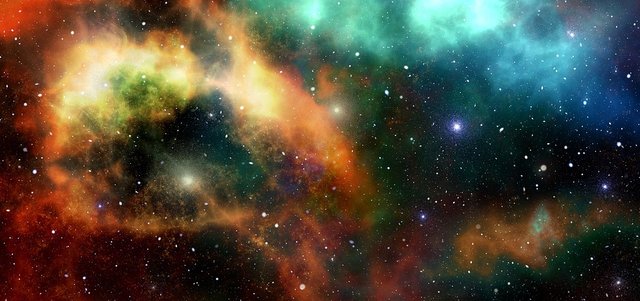The Development Rate of the Universe
Glad to be a teacher is when we get questions from students, something we have never thought of before. So to answer correctly the question, we must seek the answer by re-learning. And when we get the answer to give to our students, we also increase our knowledge. It is here that the student taught his teacher, and this is a good teaching-learning process, a reciprocal process.
There is a Question: "There are objects that are far away 46.6 billion light years away from us.If the age of the universe is 13.7 billion years old, and nothing can be faster than the speed of light, how could the object exist?"
(everything in the statement and question above is legit, meaning there is nothing wrong in the question above)
Before answering the question above, let us equate our perception of matters relating to this issue (of course with the widely accepted knowledge today)

The first, age of the Universe was 13.7 billion years. Of course There is a measurement error there ~ nobody will be surprised if its age is 13.5 billion or 14.0 billion years ~ but its definitely not 12 billion years or younger and definitely not 16 billion years old or older.
Secondly, Nothing can move faster than the speed of light. Whether it is a galaxy, a spacecraft, a bullet or even a neutrino, if it has mass, it must be slower than the speed of light. And if it does not have mass, then it will be exactly equal to the speed of light.
Third, The furthest objects in the universe - objects of objects that emit their light 13.7 billion years ago ~ are 46.5 billion light years away from us today.
So how does this happen? Two things, one simple and one not so simple. The simple thing is that this universe has been expanding all the time. Imagine you have an ant on a deflated balloon, and ants move at 1 cm / sec. When the balloon is completely deflated, the ants are only 2 cm from the top of the balloon, the goal. But as he started walking upwards, something made the balloon expand. As he walked up, he noticed that the balloon around him was growing expanding.
How does this expansion work? Well, this is the not so simple part. Expansion is not a speed, but is a speed-per-unit-distance. Suppose that this balloon expansion is 0.4 cm / sec per centimeter. This means that if the ant is 1 cm from a point of dibalon, and since the balloon expands, it will move away from it 0.4 cm per second, so that one second later it is 1.4 cm away from it. The top of the balloon, which is initially 2 cm apart, will stay away 0.8 cm per second. And something originally spaced 15 cm away 6 cm per second.
So because the ant speed is 1 cm / sec and the goal distance is 2 cm, it does not mean the ants get to the destination in 2 seconds, because the goal is away. But ants will take a longer time that is 3 seconds. And if this ant after reaching the destination then look back to see where he left earlier, the distance is not 2 cm, but 6 cm. Not only was the place he had departed three times as large, but all the places in the balloon were also three times farther away from him.
And that is what our Universe has done to this day, that is, it is expanding. And the rate of development (expansions) of the universe is actually slow, about 72 kilometers per second per megaparsec. If we convert into the ant world above, it equals 2.3 x 10-18cm / sec / cm. It's just that because our universe is so big, because you've been so far (under 13 billion light years), the rate of expansion of the universe has finally become greater than the speed of light.
But this does not violate the principle of No. 2 above, which states that no matter / object is faster than light, Because this is the development of space and still no matter that moves faster than light. And that's why, although the universe is only 13.7 billion years old, we can see objects of objects that are located 46.5 billion light years away.
Reference :
- http://www.everyjoe.com/2007/02/06/technology/how-can-we-see-galaxies-47-billion-light-years-away-when-the-universe-is-only-13-billion-years-old-191/
- https://physics.stackexchange.com/questions/315038/does-universe-really-expand-what-if-the-speed-of-light-is-decreasing-instead
- https://en.wikipedia.org/wiki/Observable_universe
- https://www.reddit.com/r/explainlikeimfive/comments/72461k/eli5_how_can_we_know_that_the_observable_universe/



Your second image is improperly sourced.
Congratulations! This post has been upvoted from the communal account, @minnowsupport, by alf4t1h from the Minnow Support Project. It's a witness project run by aggroed, ausbitbank, teamsteem, theprophet0, someguy123, neoxian, followbtcnews, and netuoso. The goal is to help Steemit grow by supporting Minnows. Please find us at the Peace, Abundance, and Liberty Network (PALnet) Discord Channel. It's a completely public and open space to all members of the Steemit community who voluntarily choose to be there.
If you would like to delegate to the Minnow Support Project you can do so by clicking on the following links: 50SP, 100SP, 250SP, 500SP, 1000SP, 5000SP.
Be sure to leave at least 50SP undelegated on your account.
Interesting one @alf4t1h
I always wonder like we have our boundaries on earth like we know its round like a ball but what about the universe? How much big it is and what the end...............just can't imagine